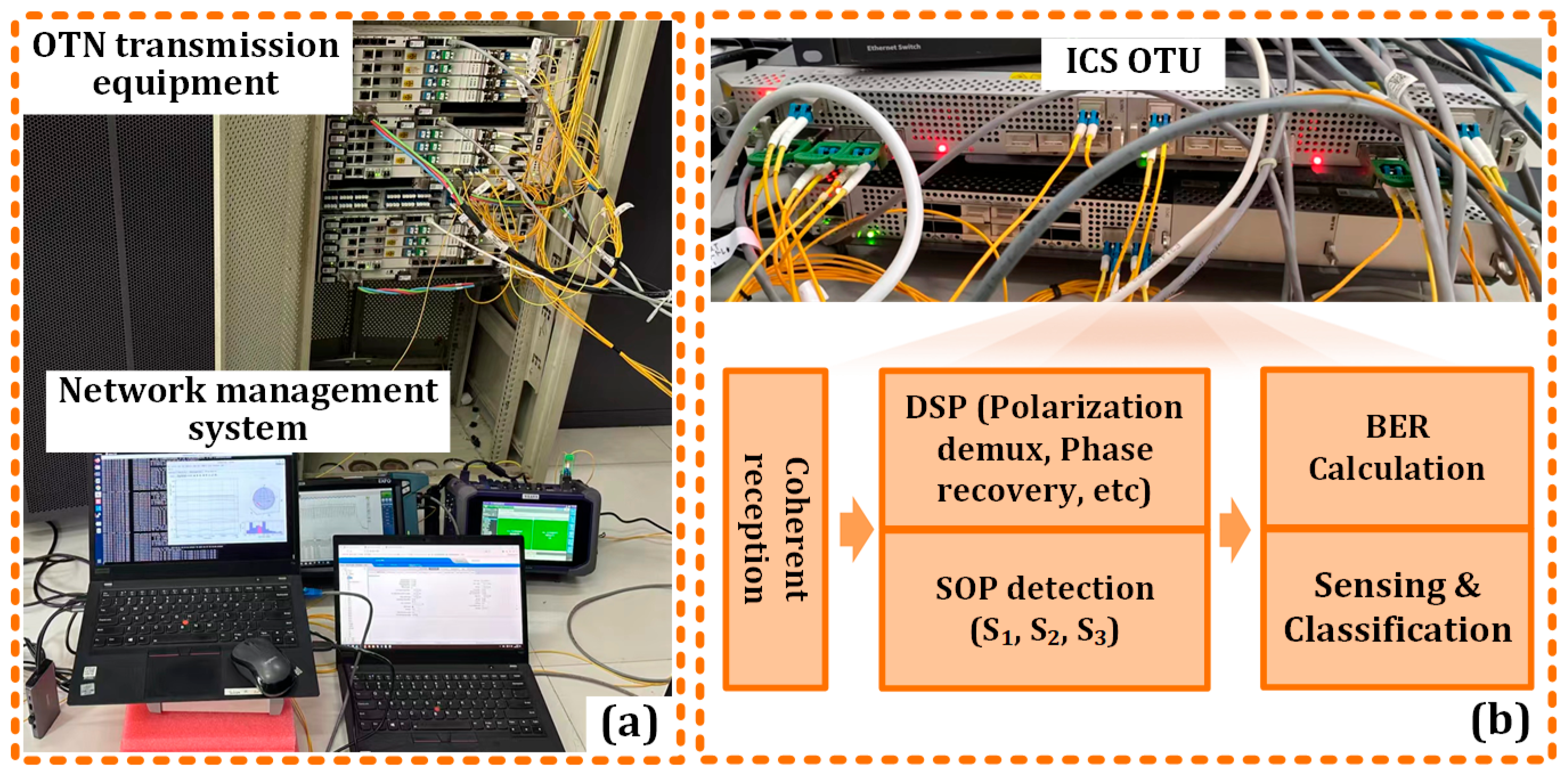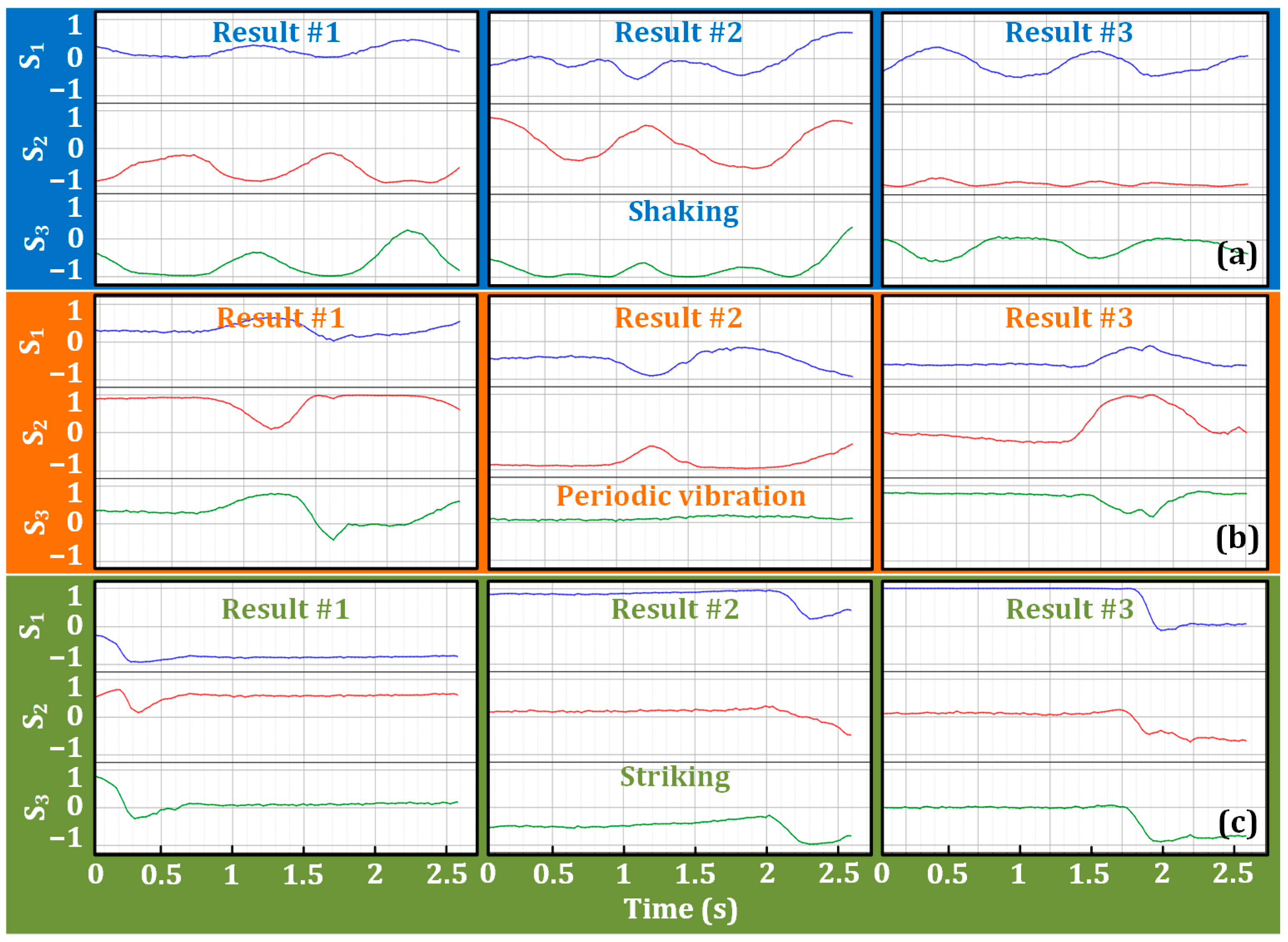First Real-Time 267.8 Tb/S 2 × 70.76 Km Integrated Communication and Sensing Field Trial over Deployed Seven-Core Fiber Cable Using 130 Gbaud PCS-64QAM 1.2 Tb/S OTN Transponders
Abstract
1. Introduction
2. Ultra-High-Speed MCF-Based ICS OTN Prototype System
3. Ultra-High-Speed 1.2 Tb/S OTU and 200 Gb/S ICS OTU
4. The Field-Deployed Seven-Core MCF Cable
5. Experimental Results of the Ultra-High-Speed ICS CDM Transmission System
6. Discussion and Prospection
7. Conclusions
Author Contributions
Funding
Institutional Review Board Statement
Informed Consent Statement
Data Availability Statement
Conflicts of Interest
References
- Guerrier, S.; Mecozzi, A.; Dorize, C.; Antonelli, C.; Dallachiesa, L.; Mardoyan, H.; Awwad, E.; Orsuti, D.; Palmieri, L.; Mazur, M.; et al. Field Trial of High-Resolution Distributed Fiber Sensing over Multicore Fiber in Metropolitan Area with Construction Work Detection using Advanced MIMO-DAS. In Proceedings of the 2023 Optical Fiber Communications Conference and Exhibition (OFC), San Diego, CA, USA, 5–9 March 2023. [Google Scholar]
- Chen, Y.; Xiao, Y.; Chen, S.; Xie, F.; Liu, Z.; Wang, D.; Yi, X.; Lu, C.; Li, Z. Field Trials of Communication and Sensing System in Space Division Multiplexing Optical Fiber Cable. IEEE Commun. Mag. 2023, 61, 182–188. [Google Scholar] [CrossRef]
- Fasano, M.; Hayashi, T.; Nagashima, T.; Mecozzi, A.; Antonelli, C.; Boffi, P. Real-Time Urban Sensing by In-Fiber Interferometric System over Field-Deployed Uncoupled 4-Core Fiber Cable. In Proceedings of the 2024 Optical Fiber Communications Conference and Exhibition (OFC), San Diego, CA, USA, 24–28 March 2024. [Google Scholar]
- Awad, H.; Usmani, F.; Straullu, S.; Bratovich, R.; Virgillito, E.; Aquilino, F.; Proietti, R.; Curri, V. Experimental Validation for Early Earthquake Detection Using Transfer Learning. In Proceedings of the 2025 Optical Fiber Communications Conference and Exhibition (OFC), San Francisco, CA, USA, 30 March–3 April 2025. [Google Scholar]
- Liu, Y.; Wang, D.; Li, Y.; Deng, J.; Yang, H.; Zhao, Y.; Zuo, M.; Zhang, D.; Li, H. Highly-precise Fiber Co-route Segment Location with Multi-modal Vibration Analysis and Field Demonstration for Intelligent Optical Network. In Proceedings of the 2025 Optical Fiber Communications Conference and Exhibition (OFC), San Francisco, CA, USA, 30 March–3 April 2025. [Google Scholar]
- Richardson, D.J.; Fini, J.M.; Nelson, L.E. Space-division multiplexing in optical fibres. Nat. Photonics 2013, 7, 354–362. [Google Scholar] [CrossRef]
- Soma, D.; Beppu, S.; Wakayama, Y.; Igarashi, K.; Tsuritani, T.; Morita, I.; Suzuki, M. 257-Tbit/s Weakly Coupled 10-Mode C + L-Band WDM Transmission. J. Light. Technol. 2018, 36, 1375–1381. [Google Scholar] [CrossRef]
- Beppu, S.; Kikuta, M.; Soma, D.; Yaegashi, Y.; Igarashi, K.; Shigihara, M.; Aizawa, K.; Yoshikane, N.; Tsuritani, T. Real-time 6-Mode 19-Core Fiber Transmission. In Proceedings of the 2023 Optical Fiber Communications Conference and Exhibition (OFC), San Diego, CA, USA, 5–9 March 2023. [Google Scholar]
- Sillard, P.; Molin, D.; Bigot-Astruc, M.; Amezcua-Correa, A.; Jongh, K.; Achten, F. 50 μm Multimode Fibers for Mode Division Multiplexing. J. Light. Technol. 2016, 34, 1672–1677. [Google Scholar] [CrossRef]
- Ryf, R.; Fontaine, N.K.; Wittek, S.; Choutagunta, K.; Mazur, M.; Chen, H.; Alvarado-Zacarias, J.C.; Amezcua-Correa, R.; Capuzzo, M.; Kopf, R.; et al. High-Spectral-Efficiency Mode-Multiplexed Transmission over Graded-Index Multimode Fiber. In Proceedings of the 2018 European Conference on Optical Communication (ECOC), Rome, Italy, 23–27 September 2018. [Google Scholar]
- Wang, F.; Gao, R.; Li, Z.; Liu, J.; Cui, Y.; Xu, Q.; Pan, X.; Zhu, L.; Wang, F.; Guo, D.; et al. OAM mode-division multiplexing IM/DD transmission at 4.32 Tbit/s with a low-complexity adaptive-network-based fuzzy inference system nonlinear equalizer. Opt. Lett. 2024, 49, 430–433. [Google Scholar] [CrossRef] [PubMed]
- Rademacher, G.; Luis, R.S.; Puttnam, B.J.; Fontaine, N.K.; Mazur, M.; Chen, H.; Ryf, R.; Neilson, D.T.; Dahl, D.; Carpenter, J.; et al. 1.53 Peta-bit/s C-Band Transmission in a 55-Mode Fiber. In Proceedings of the 2022 European Conference on Optical Communication (ECOC), Basel, Switzerland, 18–22 September 2022. [Google Scholar]
- Feng, L.; Zhang, A.; Guo, H.; Lou, X.; Wang, D.; Peng, C.; Liu, Y.; Lv, K.; Liu, H.; Huo, X.; et al. Real-Time 179.2Tb/s Transmission using Commercial 400Gb/s Transceivers over 350 km Multicore Fiber. In Proceedings of the 2023 Optical Fiber Communications Conference and Exhibition (OFC), San Diego, CA, USA, 5–9 March 2023. [Google Scholar]
- Yan, H.; Liu, H.; Du, W.; Wang, Y.; Yuan, S.; Wang, Y.; Chen, M.; Sun, W.; Lao, X.; Zhang, G.; et al. Record Long-Haul Transmission with FIFO-Less Multicore EDFA Over 125-μm Cladding MCF. In Proceedings of the 2023 Asia Communications and Photonics Conference/2023 International Photonics and Optoelectronics Meetings (ACP/POEM), Wuhan, China, 4–7 November 2023. [Google Scholar]
- Kremp, T.; Liang, Y.; McCurdy, A.H. Less Than 0.03 dB Multicore Fiber Passive Fusion Splicing Using New Azimuthal Alignment Algorithm and 3-Electrode Arc-Discharging System. In Proceedings of the 2022 European Conference on Optical Communication (ECOC), Basel, Switzerland, 18–22 September 2022. [Google Scholar]
- Shikama, K.; Abe, Y.; Kishi, T.; Takeda, K.; Fujii, T.; Nishi, H.; Matsui, T.; Aratake, A.; Nakajima, K.; Matsuo, S. Multicore-Fiber Receptacle with Compact Fan-In/Fan-Out Device for SDM Transceiver Applications. J. Light. Technol. 2018, 36, 5815–5822. [Google Scholar] [CrossRef]
- Yan, G.; Yang, M.; Cai, C.; Wang, K.; Han, B.; Zhen, S.; Wan, Z.; Zhu, Y.; Zhang, H.; Yao, C.; et al. Spatial-division multiplexing self-homodyne coherent transmission over 19-/24-core fibers assisted by homemade fan-in/fan-out 3D photonic devices. Opt. Express 2024, 32, 47982–47992. [Google Scholar] [CrossRef] [PubMed]
- Soma, D.; Beppu, S.; Miyagawa, Y.; Yoshikane, N.; Tsuritani, T. 114 Pbit/s∙km Transmission using Three Vendor-Installed 60-km Standard Cladding Multi-Core Fiber Spans with Multiple Fusion Splicing. In Proceedings of the 2023 Optical Fiber Communications Conference and Exhibition (OFC), San Diego, CA, USA, 5–9 March 2023. [Google Scholar]
- Antonelli, C.; Mecozzi, A.; Marotta, A.; Graziosi, F.; Di Sciullo, G.; Ribezzo, D.; Mazur, M.; Fontaine, N.K.; Dallachiesa, L.; Ryf, R.; et al. Field Transmission Performance of Multi-core and Few-Mode Fibers. In Proceedings of the 2024 Optical Fiber Communications Conference and Exhibition (OFC), San Diego, CA, USA, 24–28 March 2024. [Google Scholar]
- Guo, Y.; Ashry, I.; Trichili, A.; Mao, Y.; Mosquera, J.M.; Ng, T.K.; Ooi, B.S. Hybrid Optical Sensing and Communication Over a Multicore Fiber. In Proceedings of the 2022 Optical Fiber Communications Conference and Exhibition (OFC), San Diego, CA, USA, 6–10 March 2022. [Google Scholar]
- Cui, J.; Deng, Y.; Liu, Z.; Wang, Y.; Qiu, C.; Li, Z.; Wu, C.; Hao, B.; Zhang, L.; Zhang, T.; et al. First Real-time 221.9 Pb/s·km Transmission Capability Demonstration Using Commercial 138-Gbaud 400 Gb/s Backbone OTN System over Field-deployed Seven-Core Fiber Cable with Multiple Fusion Splicing. Photonics 2025, 12, 269. [Google Scholar] [CrossRef]







| Core-to-Core Distance (μm) | Mode Field Diameter (μm) | Dispersion Coefficient (ps/nm/km) | Attenuation Coefficient (dB/km) | Cut-Off Wavelength (nm) | Polarization Mode Dispersion (ps/km1/2) | Inter-Core Crosstalk (dB/10 km) | Bending Loss with R = 30 mm (dB/100 Turns) |
|---|---|---|---|---|---|---|---|
| 42 | 9.0 | ≤22 | ≤0.22 | ≤1300 | ≤0.08 | ≤−50 | <0.1 |
| Core #1 | Core #2 | Core #3 | Core #4 | Core #5 | Core #6 | Core #7 | |
|---|---|---|---|---|---|---|---|
| Span loss Total crosstalk | 25.3 | 24.2 | 20.1 | 23.9 | 24.1 | 23.8 | 25.7 |
| −47.1 | −44.3 | −42.7 | −48.2 | −46.2 | −44.3 | −47.5 |
| Core #1 | Core #2 | Core #3 | Core #4 | Core #5 | Core #6 | Core #7 | |
|---|---|---|---|---|---|---|---|
| Span loss Total crosstalk | 25.1 | 25.3 | 19.8 | 23.8 | 25.2 | 23.2 | 24.6 |
| −45.5 | −45.3 | −43.1 | −46.8 | −42.5 | −46.6 | −45.4 |
Disclaimer/Publisher’s Note: The statements, opinions and data contained in all publications are solely those of the individual author(s) and contributor(s) and not of MDPI and/or the editor(s). MDPI and/or the editor(s) disclaim responsibility for any injury to people or property resulting from any ideas, methods, instructions or products referred to in the content. |
© 2025 by the authors. Licensee MDPI, Basel, Switzerland. This article is an open access article distributed under the terms and conditions of the Creative Commons Attribution (CC BY) license (https://creativecommons.org/licenses/by/4.0/).
Share and Cite
Cui, J.; Zhang, L.; Deng, Y.; Liu, Z.; Wu, C.; Hao, B.; Zhang, T.; Wang, Y.; Wu, B.; Zhang, C.; et al. First Real-Time 267.8 Tb/S 2 × 70.76 Km Integrated Communication and Sensing Field Trial over Deployed Seven-Core Fiber Cable Using 130 Gbaud PCS-64QAM 1.2 Tb/S OTN Transponders. Photonics 2025, 12, 577. https://doi.org/10.3390/photonics12060577
Cui J, Zhang L, Deng Y, Liu Z, Wu C, Hao B, Zhang T, Wang Y, Wu B, Zhang C, et al. First Real-Time 267.8 Tb/S 2 × 70.76 Km Integrated Communication and Sensing Field Trial over Deployed Seven-Core Fiber Cable Using 130 Gbaud PCS-64QAM 1.2 Tb/S OTN Transponders. Photonics. 2025; 12(6):577. https://doi.org/10.3390/photonics12060577
Chicago/Turabian StyleCui, Jian, Leimin Zhang, Yu Deng, Zhuo Liu, Chao Wu, Bin Hao, Ting Zhang, Yuxiao Wang, Bin Wu, Chengxing Zhang, and et al. 2025. "First Real-Time 267.8 Tb/S 2 × 70.76 Km Integrated Communication and Sensing Field Trial over Deployed Seven-Core Fiber Cable Using 130 Gbaud PCS-64QAM 1.2 Tb/S OTN Transponders" Photonics 12, no. 6: 577. https://doi.org/10.3390/photonics12060577
APA StyleCui, J., Zhang, L., Deng, Y., Liu, Z., Wu, C., Hao, B., Zhang, T., Wang, Y., Wu, B., Zhang, C., Chen, Y., Shen, L., Luo, J., Sun, Y., Wan, Q., Chang, C., Yan, B., & Gu, N. (2025). First Real-Time 267.8 Tb/S 2 × 70.76 Km Integrated Communication and Sensing Field Trial over Deployed Seven-Core Fiber Cable Using 130 Gbaud PCS-64QAM 1.2 Tb/S OTN Transponders. Photonics, 12(6), 577. https://doi.org/10.3390/photonics12060577





